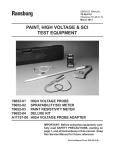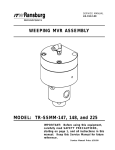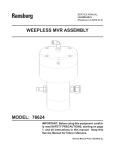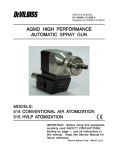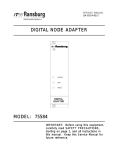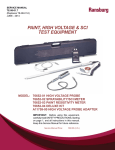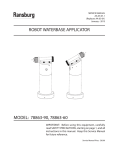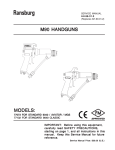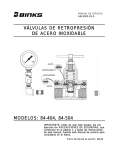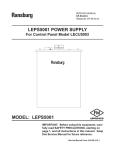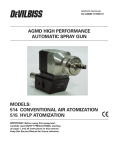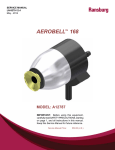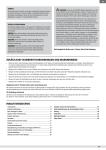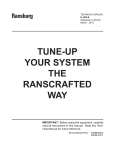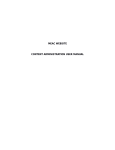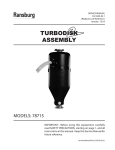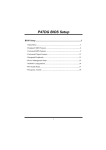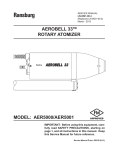Download Product Manual
Transcript
SERVICE MANUAL TE-98-01.5 - September 2006 (Replaces TE-98-01.4) PAINT TAGE & SCI AINT,, HIGH VOL VOLT TEST EQUIPMENT 76652-01 76652-02 76652-03 76652-04 A1 1757-00 A11757-00 HIGH VOL TAGE PROBE VOLT SPRA YABILITY/SCI METER SPRAY PAINT RESISTIVITY METER DELUXE KIT HIGH VOL TAGE PROBE ADAPTER VOLT IMPOR TANT IMPORT ANT:: Before using this equipment, carefully read SAFETY PRECAUTIONS, starting on page 1, and all instructions in this manual. Keep this Service Manual for future reference. Service Manual Price: $30.00 (U.S.) N O T E : This manual has been changed from revision TE-98-01.4 to revision TE-98-01.5 TE-98-01.5. Reasons for this change are noted under “Manual Change Summary” inside the back cover of this manual. TE-98-01.5 Paint, High Voltage & SCI Test Equipment - Contents CONTENTS SAFETY: PAGE 1 - 3 SAFETY PRECAUTIONS........................................................................................................... 1 HAZARDS/SAFEGUARDS......................................................................................................... 2-3 TEST EQUIPMENT: 5-17 MULTI-FUNCTION ELECTROSTATIC METER........................................................................ SPRAYABILITY, SCI, AND RESISTANCE MEASUREMENT KIT.................................................................................................................. PAINT RESISTANCE MEASUREMENT KIT............................................................................. HIGH VOLTAGE MEASUREMENT KIT..................................................................................... GENERAL MAINTENANCE....................................................................................................... 5-6 WARRANTY POLICIES: 19 7-12 12-13 14-16 17 LIMITED WARRANTY................................................................................................................. 19 APPENDIX: 20-23 PAINT AND SOLVENT SPECIFICATIONS............................................................................... 20 VISCOSITY CONVERSION CHART......................................................................................... 21-22 VOLUMETRIC CONTENT OF HOSE OR TUBE...................................................................... 23 TE-98-01.5 Paint, High Voltage & SCI Test Equipment - Safety SAFETY SAFETY PRECAUTIONS Before operating, maintaining or servicing any ITW Ransburg coating system, read and understand all of the technical and safety literature for your ITW Ransburg products. This manual contains information that is important for you to know and understand. This information relates to USER SAFETY and PREVENTING EQUIPMENT PROBLEMS. To help you recognize this information, we use the following symbols. Please pay particular attention to these sections. A WARNING! states information to alert you to a situation that might cause serious injury if instructions are not followed. A CAUTION! states information that tells how to prevent damage to equipment or how to avoid a situation that might cause minor injury. A NOTE is information relevant to the procedure in progress. While this manual lists standard specifications and service procedures, some minor deviations may be found between this literature and your equipment. Differences in local codes and plant requirements, material delivery requirements, etc., make such variations inevitable. Compare this manual with your system installation drawings and appropriate ITW Ransburg equipment manuals to reconcile such differences. ! WARNING The user MUST read and be familiar with the Safety Section in this manual and the ITW Ransburg safety literature therein identified. > > This manual MUST be read and thoroughly understood by ALL personnel who operate, clean or maintain this equipment! Special care should be taken to ensure that the WARNINGS and safety requirements for operating and servicing the equipment are followed. The user should be aware of and adhere to ALL local building and fire codes and ordinances as well as NFPA-33 SAFETY STANDARD, prior to installing, operating, and/or servicing this equipment. ! WARNING > The hazards shown on the following page may occur during the normal use of this equipment. Please read the hazard chart beginning on page 2. Careful study and continued use of this manual will provide a better understanding of the equipment and process, resulting in more efficient operation, longer trouble-free service and faster, easier troubleshooting. If you do not have the manuals and safety literature for your Ransburg system, contact your local ITW Ransburg representative or ITW Ransburg. 1 TE-98-01.5 Paint, High Voltage & SCI Test Equipment - Safety AREA HAZARD SAFEGUARDS Tells where hazards Tells what the hazard is. Tells how to avoid the hazard. may occur. Spray Area Electrostatic Arcing Never operate the spray gun without properly grounding the following: A. Operators Operators must be grounded. Rubber soled insulating shoes should not be worn. Grounding leg straps may be used. Operators must maintain contact with the handle of the gun. If work gloves are used, the palm section should be cut out. Operators must remove from themselves all metal objects that are not grounded. NOTE: REFER TO NFPA-33 REGARDING OPERATOR GROUNDING B. Parts being sprayed. Resistance between the part and a grounded conveyor must not exceed 1 megohm. C. Every metal and conductive object in the spray area. This includes the booth, parts hangers, fire extinguishers, conductive flooring, etc. Grounded conductive flooring must be provided in the spray area. Turn off voltage at the power supply before flushing out, cleaning, or removing any parts from the gun. Provide proper protection for waterborne supply systems. Never install a spray gun into a fluid system using an isolated solvent supply. Always discharge Waterborne system capacitance prior to servicing. Do not touch gun electrode while gun is energized. TE-98-01.5 2 Paint, High Voltage & SCI Test Equipment - Safety AREA HAZARD SAFEGUARDS Tells where hazards Tells what the hazard is. Tells how to avoid the hazard. may occur. Toxic Substances Certain materials may be harmful if inhaled or if there is contact with the skin. Follow the requirements of the Material Safety Data Sheet supplied by your coating material manufacturer. Adequate exhaust must be provided to keep the air free of accumulations of toxic materials. Use a mask or respirator whenever there is a chance of inhaling sprayed materials. The mask must be compatible with the material being sprayed and its concentration. Equipment must be as prescribed by an industrial hygienist or safety expert, and be NIOSH approved. General Use and Maintenance Improper operation or maintenance may create a hazard. Personnel must be properly trained in the use of this equipment. 3 Personnel must be given training in accordance with the requirements of NFPA-33. Instructions and safety precautions must be read and understood prior to using this equipment. Comply with appropriate local, state, and national codes governing ventilation, fire protection, operation, maintenance, and housekeeping. Reference OSHA, NFPA-33, and your insurance company requirements. TE-98-01.5 Paint, High Voltage & SCI Test Equipment - Safety NOTES TE-98-01.5 4 Paint, High Voltage & SCI Test Equipment MUL TI-FUNCTION MULTI-FUNCTION ELECTROST ATIC METER ELECTROSTA The ITW Ransburg Multi-Function Electrostatic Spray Meter uses one meter to serve multifunctions in electrostatic spray finishing. The meter can be used to measure conductivity, paint resistance, short circuit current, resistance, and high voltage. The meter is available in individual kits focused on each function or a deluxe kit, which includes accessories to perform all the functions listed above. The ITW Ransburg Multi-Function Electrostatic Spray Meter is powered by a single 9V alkaline battery. The solid state circuitry only requires 9V input to power the meter display and condition all the signals from the accessory items. Part # Description 76652-01 Kit for measuring high voltage. Includes 76634-00 Multi-Function Meter and 76667 High Voltage Probe Assembly. 76652-02 Kit for measuring short circuit current (SCI),resistance and sprayability. Includes 76634-00 Multi-Function Meter and 76664-00 Test Lead Assembly. 76652-03 Kit for measuring paint resistivity. Includes 76634-00 Multi-Function Meter and 7922-00 Paint Probe Assembly. 76652-04 Deluxe Kit Performs all functions listed above. Includes 76634-00 Multi-Function Meter, 7922-00 Paint Probe Assembly, 76664-00 Test Lead Assembly, and 76667-00 High Voltage Probe Assembly. A11757-00 High Voltage Probe Adapter Adapter to measure the voltage coming from an individual probe (electrode) assembly on RMA-303 Indirect Charge Robot Mounted Rotary Atomizer (A11600, A11300), Aerobell 2.5 Indirect Charge (A10924), and Aerobell II Indirect Charge (77603). Meter Scale Ranges:* kV: 0 to ±199.9 kVDC μA: 0 to ±1999 μA kΩ: 1 to 1999 kΩ (.001 to 1.999 MΩ) MΩ: 00.1MΩ to 199.9 MΩ GΩ: .1GΩ to 19.99 GΩ * Note: For readings below 2 MΩ, more resolution can be obtained by using the kΩ scale. 5 TE-98-01.5 Paint, High Voltage & SCI Test Equipment Figure 1A: Multi-Function Meter Figure 1B: Multi-Function Meter Kit Parts TE-98-01.5 6 Paint, High Voltage & SCI Test Equipment SPRA YABILITY SPRAY ABILITY,, SCI, AND RESIST ANCE RESISTANCE MEASUREMENT KIT Sprayability The Sprayability Meter measures whether materials normally considered being electrically non-conductive could be electrostatically sprayed or whether they need to be treated with solutions to make the surface conductive. The meter measures the surface resistance and indicates the degree of sprayability in MΩ or GΩ. The target being sprayed must be low enough in resistance to dissipate the electrostatic charge. In some cases the internal resistance of a target is lower than the surface resistance. This might allow a target that does not have a suitable surface resistance reading to be coated electrostatically without additional surface preparation. An example of this is certain types of wood which on the surface are not conductive but due to moisture content (12%-13%) may be sprayable. Since many non-conductive products must be pre-treated with a conductive solution to make them sprayable, the ITW Ransburg Multi-Function Electrostatic Spray Meter is useful to monitor and maintain consistency in that application, once a suitable reading is determined. ! and re-perform the check. If the meter still does not read zero, consult the factory for repair of the meter. 2. With the metallic part of the meter probes pressed firmly and perpendicular against the surface of the article to be tested, the meter automatically reads the resistance of the part. Table 1 lists the readings from an 8333-00 meter and compares it to the readings of the MultiFunction Meter. Meter Readings 0Ω to 1.0G Ω - The article is suitable for spraying 1.0GΩ using the electrostatic process. 1.0G Ω to 1.5G Ω - The article is questionable for 1.0GΩ 1.5GΩ spraying using the electrostatic process. In such cases, paint a trial sample article to determine if a conductive primer or conductive solution for the part surface is required. 1.5G Ω to Infinity - The article is NOT suitable 1.5GΩ for spraying. A conductive primer or conductive solution is required to treat the surface of the part. CAUTION > Ensure that meter's scale is properly set for the function in which it is being used. Damage to equipment may result if improperly set. Operation 1. Set the meter dial to the MΩ or GΩ scale (see Figure 2). Check the meter calibration by touching the metallic end of the two (2) probes on the meter to the stripped bare ends of a single 12" long wire (see Figure 2). (If desired the continuity of the wire may be verified by using a Volt-Ohm meter). If the meter reads zero, the meter is in calibration. If it does not read zero, verify the continuity of the wire 7 Figure 2: Sprayability Test Meter TE-98-01.5 Paint, High Voltage & SCI Test Equipment New 76652-01 Multi-Function Meter Reading 1 MΩ 8333-00 Sprayability Meter Reading 155 Spray Condition Suitable 2 MΩ 150 Suitable 3 MΩ 147 Suitable 4 MΩ 145 Suitable 14 MΩ 140 Suitable 60 MΩ 135 Suitable 190 MΩ or .1 GΩ 130 Suitable 320 MΩ or .3 GΩ 125 Suitable 410 MΩ or .4 GΩ 120 Suitable 500 MΩ or .5 GΩ 115 Suitable 600 MΩ or .6 GΩ 110 Suitable 760 MΩ or .7 GΩ 105 Suitable 1020 MΩ or 1.0 GΩ 100 Suitable 1.1 GΩ 98 Test Sample Part 1.3 GΩ 95 Test Sample Part 1.5 GΩ 90 Test Sample Part 2.0 GΩ to Infinity 85 or less Requires Surface Prep Table 1: Comparison to 8333-00 Sprayability Meter with New Multi-Function Meter TE-98-01.5 8 Paint, High Voltage & SCI Test Equipment Resistance/T esting Resistance/Testing Target/Product Ground The ITW Ransburg Multi-Function Meter may be used to measure approximate resistance in kΩ, MΩ, or GΩ. Applications for the meter range from measuring the resistance of a 70430-XX resistor to measuring the resistance of a target to ground. ! CAUTION > Ensure that meter's scale is properly set for the function in which it is being used. Damage to equipment may result if improperly set. Operation 1. Set the meter dial to the MΩ scale (see Figure 3). Plug the probe with two (2) alligator clamp leads into the side of the meter. Check the meter calibration by touching the metallic ends of the two (2) probes together. If the meter reads zero, the meter is in calibration. If it does not read zero, verify the continuity of the probe assembly and reperform the check. If the meter still does not read zero, consult the factory for repair of the meter. 2. For ground checks, attach one alligator clip to a clean, non-treated surface of the target to be sprayed. Attach the other alligator clip to a known true earth ground. Set the dial to the MΩ scale. Read the resistance. If the resistance is greater than 1.0 MΩ the part is not adequately grounded (reference NFPA-77, NFPA-33). NOTE > When using the Multi-Function Meter test leads to measure resistance or current, ensure that the sprayability probes do not come into contact with any surface or the meter readings may be altered. ! WARNING > If the reading between true earth ground and the target is greater than 1.0 MΩ, then the hooks, racks, supports, etc. must be cleaned and eventually demonstrate a true earth ground resistance of 1.0 MΩ or lower. See NFPA-33 for further information. 3. For resistance checks, set the meter to MΩ scale (see Figure 4). Attach one alligator clip to the electrode wire of a 70430-XX screwed onto a needle shaft (or similar component). Attach the other lead to the shaft of the needle shaft (or other end of a similar component). The electrode reading should be approximately 14.5 MΩ to 19MΩ. Figure 3: 9 Calibration Check Resistance TE-98-01.5 Paint, High Voltage & SCI Test Equipment ! CAUTION > Ensure that meter's scale is properly set for the function in which it is being used. Damage to equipment may result if improperly set. Operation ! WARNING > Prior to starting the SCI tests, ensure the voltage at the power supply is turned off. 1. Set the meter dial to the μA scale (see Figure 5). Plug the probe with two (2) alligator clamp leads into the side of the meter. Ensure the meter reads zero. If it does not read zero, consult the factory for repair of the meter. Figure 4: Measuring Electrode Resistance Short Circuit Current-SCI (Power Supplies) The ITW Ransburg Multi-Function Meter may be used to measure the short circuit current of an electrostatic product. The short circuit current measurement is important in troubleshooting problems with electrostatic power supplies and applicators. These tests should be performed when a noticeable decrease in transfer efficiency occurs. The measured short circuit current value should be compared to the value listed in the appropriate power supply or applicator manual. This comparison indicates if there are problems with the power source or the applicator. TE-98-01.5 2. Place appropriate test resistor (see Table 2) in the high voltage cable socket of the power supply. Be sure it is pushed clear to the bottom or proper contact will not be made. Attach one of the alligator clamps to the lead of the test resistor. Attach the other alligator clamp to a known true earth ground. Turn the power supply on. Then trigger H.V. by the air flow switch or jumper as required by gun model. (See appropriate service manual for further information.) Be sure that the power supply lights indicate that high voltage is being generated. Measure and record the short circuit current from the meter. This value should be compared to the value listed in the appropriate power supply service manual. A brief listing of ITW Ransburg power supply short circuit current readings is listed in Table 3. 10 Paint, High Voltage & SCI Test Equipment Short Circuit Current-SCI (Guns) The ITW Ransburg Multi-Function Meter may be used to measure the short circuit current of an electrostatic applicator. The short circuit current measurement is important in troubleshooting problems with electrostatic power supplies and applicators. These tests should be performed when a noticeable decrease in transfer efficiency occurs. The measured short circuit current value should be compared to the value listed in the appropriate power supply or applicator manual. This comparison indicates if there are problems with the power source or the applicator. ! 2. Attach one of the alligator clamps to the electrode (brush on the #2 process bell). Be sure the clamp makes good contact with the electrode (small wires on the #2 brush). Attach the second alligator clamp to ground, preferably the handle or bracket. 3. Apply voltage to the gun from the power supply. The meter should read between the ranges indicated in Table 3. Consult power supply and applicator manuals for readings outside these ranges. CAUTION > Ensure that meter's scale is properly set for the function in which it is being used. Damage to equipment may result if improperly set. Operation ! WARNING > Prior to starting the SCI tests, ensure the voltage at the power supply is turned off. 1. Set the meter dial to the μA scale (see Figure 5). Plug the probe with two (2) alligator clamp leads into the side of the meter. Check the meter calibration by touching the metallic ends of the two (2) probes together. If the meter reads zero, the meter is in calibration. If it does not read zero, verify the continuity of the probe assembly and reperform the check. If the meter still does not read zero, consult the factory for repair of the meter. 11 Figure 5: Testing SCI on Power Supplies Resistor Part No. 16688-01 R e s i s t a n c e Power Supply Ω for Use With MΩ In M 160 Dry Paks, Porta Paks, 9040 Classic Power Supplies REA-III, REA-IV, REM Classic 16688-02 525 All #2 Power Supplies Table 2. SCI Test Resistors and Power Supplies TE-98-01.5 Paint, High Voltage & SCI Test Equipment Power Supply SCI Range in μA 79344-XXX, 9050 Classic, Vector R90/70 140 μA 76447-10X, 9040 Classic, REA-IV 100-150 μA 76447-11X, 9040 Classic, REM Classic 75-100 μA 76447-12X, 9040 Classic, REAIII Hand 100-150 μA 76447-13X, 9040 Classic, REAIII Auto 125-175 μA 76657-14X, 9040 Classic, No. 2 Gun 75-110 μA 76304-02,-04, Dry-Pak, REAIV, REH 200-225 μA 70918-01, Porta-Pak, REAIII Hand 160-200 μA 70394-02, Porta-Pak, REAIII Auto 170-220 μA 19219-02, 70360-01, Porta-Pak, No. 2 80-100 μA Table 3. Power Supplies and SCI Values PAINT RESIST ANCE RESISTANCE MEASUREMENT KIT Paint Resistivity The ITW Ransburg Paint Resistance Measurement Kit using the multi-function meter is designed to provide measurement of the electrical resistance of paint formulations for all electrostatic applications. Once the resistance of a paint is determined and found to spray successfully, measuring resistivity with this meter provides a way to duplicate conditions. This is extremely important when troubleshooting problems with spray or rotational applicators. This meter has two (2) scales, MΩ and kΩ that may be used for measurement of the paint resistance. TE-98-01.5 ! CAUTION > Testing Metallic Paint In certain paint formulations where materials of appreciable content of metal flake or powder (i.e., aluminum, bronze, or metallic colors) are used, this method of testing resistance can be misleading or inconclusive. This paint tester will NOT indicate the metallic content of the formula. Whenusing the paint tester with metallic paints, the low voltage battery of the test probe may not be enough to influence the metal particles, therefore, their presence may go unrecognized by the meter. When such formulations are placed in electrostatic applicators and high voltage applied, the metal particles may become aligned by the electrical field. This may result in an appreciable increase of current flow to ground by way of the pain delivery system. While the flow of current poses no immediate dangerous condition, it may drain some or all of the voltage from the electrode and may reduce or eliminate electrostatic efficiency. ! CAUTION > Ensure that meter's scale is properly set for the function in which it is being used. Damage to equipment may result if improperly set. 12 Paint, High Voltage & SCI Test Equipment Meter Readings Table 4 lists the ranges of paint resistivity that work best for specific ITW Ransburg applicators. Applicator Paint Resistivity Range Aerobell, Aerobell 33, Disks 0.05 MΩ to 1.0MΩ #2 Process Handgun 0.1 MΩ to 1.0MΩ Vector, REA, or REM guns 0.1 MΩ to Infinity Table 4. Paint Resistivity Ranges * Figure 6: Paint Tester Operation Operation 1. Set the meter dial to the MΩ scale (see Figure 6). Plug the paint probe into the side of the meter. 2. Immerse the probe vertically into a well-mixed representative sample of the subject paint until the holes at the bottom of the slots in the probe sleeve are submerged (see Figure 6). Take a reading within 5 to 10 seconds of submerging the probe. ! CAUTION > Do not immerse the paint probe past the top of the sleeve. *Use this table as a guideline. Usually a trial for resistance above listed values is recommended. When resistance is below listed values, electrostatic effect will be reduced due to a higher current draw to ground. To spray this material may require other means of increasing distance to ground such as adding coiled fluid tubes. To obtain MΩ - CM from the resistance in MΩ from the meter, multiply by 132. MΩ - CM = MΩ reading X 132 (Ref. ASTM D5628) Maintenance The test probe MUST be cleaned IMMEDIATELY after each use. Use a suitable solvent and clean cloth to thoroughly clean the probe assembly. 1. Remove the probe sleeve and clean it inside and out, removing all paint residues (it may be soaked while probe is cleaned). 2. Thoroughly clean the outside of the probe with the cloth and solvent. ! CAUTION > NEVER soak the paint probe. There is no solvent seal at the point where the handle screws into the body of the probe. If solvent is allowed to enter at this point or where the cable enters at the top of the handle, the interior wiring will deteriorate and have to be replaced. 3. Place the cleaned sleeve back on the probe. 13 TE-98-01.5 Paint, High Voltage & SCI Test Equipment HIGH VOL TAGE VOLT MEASUREMENT KIT High V oltage Measurement Voltage The ITW Ransburg High Voltage Measurement Kit using the multi-function meter is designed to provide measurement of high voltage DC potential for all electrostatic applicators to 200kV. Having an accurate measurement of output voltage from an applicator is very important when troubleshooting problems with an installation. The reading from this device indicates whether the applicator and power supply are operating correctly. This kit comes with the following accessories: 1. A high voltage probe assembly to measure DC voltage at a bell, disk or gun. 2. Five (5) feet of 3/8 inch diameter high voltage cable to measure DC voltage from power supplies of 90kV and higher. 3. Five (5) feet of 5/16 inch diameter high voltage cable to measure DC voltage from power supplies producing less than 90kV. ! WARNING > The ground clip MUST be connected to a proven true earth ground BEFORE any contact is made between the probe assembly and the asembly being tested. All personnel in the hazard (booth) area MUST be grounded. See ITW Ransburg bulletin "Personnel Grounding". These operating instructions MUST be read and thoroughly understood by all personnel who use this equipment. Special care should be taken to ensure that all Warnings and Requirements for operating the equipment safely are followed. The user should be aware of and adhere to all relevant local and company safety and fire codes and ordinances and the Occupational Heath Act of 1970 (OSHA) prior to operating this equipment. 1. Set the meter dial to the kV scale (see Figure 7). Plug the high voltage probe into the side of the meter. ! WARNING ! CAUTION > Ensure that meter's scale is properly set for the function in which it is being used. Damage to equipment may result if improperly set. Operation ! > To provide proper equipment to operator ground, the conductive handle of the probe MUST be held in the bare hand of the operator. To avoid a shock hazard, the meter should NEVER be disconnected fromthe probe during high voltage contact. 2. Attach ground clamp to a proven earth ground. CAUTION > DO NOT exceed 30 seconds or less of continuous use of the high voltage probe. The probe is designed for instant readings TE-98-01.5 14 Paint, High Voltage & SCI Test Equipment - For Guns 3. If measuring the voltage on an electrostatic gun, line up the hole in the test probe and the electrode. Slide the test probe straight over the electrode wire of the gun. Be sure to push the test probe tight against the nozzle to minimize any voltage that may leak into the air during the test. ! CAUTION > Ensure that the applicator is NOT rotating when contacting it with the probe. Also, to get proper readings on resistive applicators, the probe must be placed in contact with the atomizing edge of the bell or disk as shown in Figure 8. As this edge is sensitive to mechanical damage, use care when contacting it with the probe. Rough handling may cause damage to the applicator. Figure 7: Measuring High Voltage On Electrostatic AIr Spray Gun NOTE > Make sure all grounded objects are at least 2 feet away. 4. Holding the metal part of the high voltage probe in your hand, trigger the gun so voltage exists at the electrode. 5. Read the voltage displayed on the meter in 30 seconds or less. 6. Turn the voltage to the gun OFF, and pull the test probe straight off the electrode. - For Bells or Disks 7. Turn the high voltage power supply on. 8. Make and maintain sure contact between the test probe and the applicator (see Figure 8). Figure 8: Measuring High Voltage On Bells or Disks 9. Read the applicator high voltage displayed on the meter in 30 seconds or less. 10. Disengage the test probe from the applicator. 11. Resume operation. - For Power Supply High Voltage Measurement 12. Remove the metal test rod by loosening the nut on the end of the wand. 13. Insert the proper diameter high voltage cable into the wand of the high voltage probe. 14. Tighten the nut as necessary. 15. Attach the ground clamp to a known true earth ground. 15 TE-98-01.5 Paint, High Voltage & SCI Test Equipment ! WARNING > The ground clip MUST be connected to a proven true earth ground BEFORE any contact is made between the probe assembly and the asembly being tested. 16. Insert the cable into the high voltage tube of the power supply, inserting it far enough to make contact with the contact spring at the bottom of the tube. 24. Tighten thumb screw. 25. Place adapter over probe (electrode) assembly (see Figure 10). Probe (electrode) assembly Adapter 17. Turn the power supply on. 18. Read the voltage displayed on the meter, 30 seconds or less. HV probe from probe test kit 19. Turn the power supply off. 20. Disengage the probe cable from the power supply. Figure 10: Electrode Test View 21. Restore the applicator connection to the power supply and resume operation. 26. Remove adapter from probe (electrode) assembly. - For Probe (Electrode) Assemblies 22. Turn on the high voltage power supply. 27. Test other probe (electrode) assemblies or resume operation. 23. Place adapter on end of high voltage probe (see Figure 9). Maintenance - Probe Thumb Screw Adapter HV probe from probe test kit Figure 9: TE-98-01.5 1. Keep the test probe and the HV cables clean to prevent contamination of the probe sockets. Clean only with non-polar solvents. 2. Inspect the ground cable, its clamp and connections for breaks or poor connections. 3. Do not bend or stress the white kV probe assembly, as this may break the potted high voltage resistor. Probe Assembly View 16 Paint, High Voltage & SCI Test Equipment GENERAL MAINTENANCE Maintenance Battery Replacement When required, the battery will need to be replaced. It may be purchased locally and is a standard alkaline type 9V battery. To replace the battery, perform the following steps (refer to Figure 11). Calibration The 76634-00 Multi-Function Meter is not field repairable. The meter should be returned to the factory for repair or recalibration. ITW Ransburg recommends that the Multi-Function Meter and its associated equipment (Paint probe, kV Probe, and/or Test Leads) be sent in together for recalibration at least once per year. 1. Remove the sliding back cover of the meter. 2. Remove the existing battery from the two (2) prong 9V connector. 3. Replace with new alkaline 9V battery. 4. Replace back cover. 5. Appropriately discard used battery. NOTE > The screen will go blank when the battery needs to be replaced. Figure 11: 17 NOTE > The best recalibration results the MultiFunction Meter and accesories (Paint probe, kV Probe, and/or Test Leads) should be sent in together for recalibration. When shipped from the factory, and after each calibration, the Multi-Function Meter will be sealed with a calibration sticker noting the next date when calibration expires. Removal of this seal will void calibration of the unit. A certificate of calibration will also be shipped with each calibrated unit. Battery Replacement TE-98-01.5 Paint, High Voltage & SCI Test Equipment NOTES TE-98-01.5 18 Paint, High Voltage & SCI Test Equipment - Warranty Policies WARRANTY POLICIES LIMITED W ARRANTY WARRANTY ITW Ransburg will replace or repair without charge any part and/or equipment that falls within the specified time (see below) because of faulty workmanship or material, provided that the equipment has been used and maintained in accordance with ITW Ransburg's written safety and operating instructions, and has been used under normal operating conditions. Normal wear items are excluded. THE USE OF OTHER THAN ITW RANSBURG APPROVED PARTS, VOID ALL WARRANTIES. SPARE PARTS: One hundred and eighty (180) days from date of purchase, except for rebuilt parts (any part number ending in "R") for which the warranty period is ninety (90) days. EQUIPMENT: When purchased as a complete unit, (i.e., guns, power supplies, control units, etc.), is one (1) year from date of purchase. WRAPPING THE APPLICATOR, ASSOCIATED VALVES AND TUBING, AND SUPPORTING HARDWARE IN PLASTIC, SHRINK-WRAP, OR ANY OTHER NONAPPROVED COVERING, WILL VOID THIS WARRANTY. 19 ITW RANSBURG'S ONLY OBLIGATION UNDER THIS WARRANTY IS TO REPLACE PARTS THAT HAVE FAILED BECAUSE OF FAULTY WORKMANSHIP OR MATERIALS. THERE ARE NO IMPLIED WARRANTIES NOR WARRANTIES OF EITHER MERCHANTABILITY OR FITNESS FOR A PARTICULAR PURPOSE. ITW RANSBURG ASSUMES NO LIABILITY FOR INJURY, DAMAGE TO PROPERTY OR FOR CONSEQUENTIAL DAMAGES FOR LOSS OF GOODWILL OR PRODUCTION OR INCOME, WHICH RESULT FROM USE OR MISUSE OF THE EQUIPMENT BY PURCHASER OR OTHERS. EXCLUSIONS: If, in ITW Ransburg's opinion the warranty item in question, or other items damaged by this part was improperly installed, operated or maintained, ITW Ransburg will assume no responsibility for repair or replacement of the item or items. The purchaser, therefore will assume all responsibility for any cost of repair or replacement and service related costs if applicable. TE-98-01.5 Paint, High Voltage & SCI Test Equipment - Appendix APPENDIX PAINT AND SOL VENT SPECIFICA TIONS SOLVENT SPECIFICATIONS R E A TM VECTOR™ EFM TM EVOL VER T M EVOLVER RECOMMENDED VISCOSITY USING A ZAHN NO. 2 PAINT ELECTRICAL RESISTANCE** RECOMMENDED DELIVERY (UP TO) 18 TO 30 SEC .1 MΩ TO ∞ 1000 cc/min REM TM / M90 TM NO. 2 HAND GUN TURBODISK T M 18 TO 30 SEC 20 TO 60 SEC 20 TO 60 SEC .1 MΩ TO ∞ .1 TO 1 MΩ .1 MΩ TO ∞ 1500 cc/min 180 cc/min 1000 cc/min AEROBELL ® II*** AEROBELL® AEROBELL ® 33 RMA-101 T M 20 TO 60 SEC .1 MΩ TO ∞ 500 cc/min GUIDE T O USABLE SOL VENT SELECTION TO SOLVENT Chemical Name Common Name Category Methylene Chloride Chlorinated Solvents DICHLOROMETHANE Aliphatic Hydrocarbons Naptha VM & P NAPHTHA Ketones ACETONE Esters METHYL ACETATE Aromatic Hydrocarbons BENZENE Esters ETHYL ACETATE Ketones MEK 2-BUTANONE Esters ISO-PROPYL ACETATE Alcohols IPA ISOPROPYL ALCOHOL Ketones MPK 2-PENTANONE Alcohols Methyl Alcohol METHANOL Esters n-Propyl Acetate PROPYL ACETATE Aromatic Hydrocarbons Toluene TOLUOL Ketones MIBK METHYL ISOBUTYL KETONE Esters ISOBUTYL ACETATE Alcohols Ethyl Alcohol ETHANOL BUTYL ACET ATE Esters ACETA ETHYLBENZENE Aromatic Hydrocarbons n-Propyl Alcohol 1-PROPANOL Alcohols sec.-Butyl Alcohol 2-BUTANOL Alcohols Xylene XYLOL Aromatic Hydrocarbons AMYL ACETATE Esters iso-Butyl Alcohol 2-METHYLPROPANOL Alcohols METHYL AMYL ACETATE Esters MIAK 5-METHYL-2-HEXANONE Ketones n-Butyl Alcohol 1-BUTANOL Alcohols 2-ETHOXYETHANOL Glycol Ethers MAK 2-HEPTANONE Ketones CYCLOHEXANONE Ketones SC#100 AROMATIC-100 Aromatic Hydrocarbons DIBK DIISOBUTYL KETONE Ketones Amyl Alcohol 1-PENTANOL Alcohols DIACETONE ALCOHOL Ketones Butyl Cellosolve 2-BUTOXYETHANOL Glycol Ethers CYCLOHEXANOL Alcohols SC#150 AROMATIC-150 Aromatic Hydrocarbons AROMATIC-200 Aromatic Hydrocarbons *CAS Flash Point †† Number (TCC) 75-09-2 8030-30-6 65oF 67-64-1 -18oF 79-20-9 90oF 71-43-2 12oF 141-78-6 24oF 78-93-3 16oF 108-21-4 35oF 67-63-0 53oF 107-87-9 104oF 67-56-1 50oF 109-60-4 55oF 108-88-3 48oF 108-10-1 60oF 110-19-0 69oF 64-17-5 7 8 oF 123-86-4 100-41-4 64oF 74oF 71-23-8 78-92-2 72oF 1330-02-07 79oF 628-63-7 106oF 78-83-1 82oF 108-84-9 96oF 110-12-3 96oF 71-36-3 95oF 110-80-5 164oF 110-43-0 102oF 108-94-1 111oF 111oF 108-83-8 120oF 71-41-0 123-42-2 133oF 111-76-2 154oF 108-93-0 111oF 149oF 203oF Evap. Rate† 14.5 10 5.6 5.3 5.1 3.9 3.8 3.4 2.5 2.5 2.1 2.1 1.9 1.6 1.5 1.4 1.0 .89 .86 .81 .80 .67 .62 .50 .50 .43 .38 .40 .29 .20 .19 .15 .12 .07 .05 .004 .003 ⇑F A S T E R S L O W E R ⇓ Elec. Res.** HIGH HIGH LOW LOW HIGH MEDIUM MEDIUM LOW LOW MEDIUM LOW LOW HIGH MEDIUM LOW LOW LOW HIGH LOW LOW HIGH MEDIUM LOW LOW MEDIUM LOW LOW MEDIUM MEDIUM HIGH MEDIUM LOW LOW LOW LOW HIGH HIGH * CAS Number: Chemical Abstract Service Number. © 05/2006 Illinois Tool Works Inc. All rights reserved. ** Electrical Resistance using the ITW Ransburg Meter. *** Solvent Base Configuration Only. † Information Obtained From: http://solvdb.ncms.org †† The lowest temperature at which a volatile fluid will ignite. Evaporation Rate is Based Upon Butyl Acetate Having a Rate of 1.0 NOTE: Chart provides resistance and control information that we feel is necessary when using ITW Ransburg equipment. TE-98-01.5 20 Paint, High Voltage & SCI Test Equipment - Appendix Din Cup 4 Sears Craftsman Cup Saybolt Universal SSU Gardner Lithographic Krebs Unit KU Gardner Holdt Bubble Ford Cup 4 Ford Cup 3 30 16 10 .15 15 30 12 25 8 A-3 80 34 17 11 Zahn 5 60 Zahn 4 5 A-4 Zahn 3 20 Zahn 2 11 Zahn 1 27 Fisher 2 DuPont Parlin 10 10 Fisher 1 DuPont Parlin 7 .1 Poise 21 Centipoise VISCOSITY CONVERSION CHART .2 20 32 13 30 15 12 10 100 37 18 12 .25 25 37 14 35 17 15 12 A-2 130 41 19 13 .3 30 43 15 39 18 19 14 A-1 160 44 20 14 .4 40 50 16 50 21 25 18 .5 50 57 17 24 29 22 .6 60 64 18 29 33 25 .7 70 20 33 36 28 .8 80 22 39 41 31 .9 90 23 44 45 32 1.0 100 25 50 50 34 1.2 120 30 62 58 1.4 140 32 66 1.6 160 1.8 2.0 2.2 210 52 22 19 15 30 260 60 24 20 16 33 320 68 27 21 18 35 370 30 23 21 37 430 34 24 23 38 480 37 10 26 25 D 40 530 41 12 10 27 27 41 E 43 580 49 14 11 31 31 45 F 46 690 58 16 13 34 34 37 50 G 48 790 66 18 14 38 38 180 41 54 50 900 74 20 16 40 43 200 45 58 H 52 1000 82 23 17 10 44 46 220 62 I 54 1100 25 18 11 51 2.4 240 65 J 56 1200 27 20 12 55 2.6 260 68 58 1280 30 21 13 58 2.8 280 70 K 59 1380 32 22 14 63 3.0 300 74 L 60 1475 34 24 15 68 3.2 320 M 1530 36 25 16 72 3.4 340 N 1630 39 26 17 76 3.6 360 O 62 1730 41 28 18 82 3.8 380 1850 43 29 19 86 4.0 400 P 64 1950 46 30 20 90 4.2 420 2050 48 32 21 95 4.4 440 Q 4.6 460 R 4.8 480 5.0 500 5.5 6.0 7.0 700 8.0 800 9.0 900 V 10.0 1000 W A B C 000 2160 50 33 22 100 66 2270 52 34 23 104 67 2380 54 36 24 109 S 68 2480 57 37 25 112 550 T 69 2660 63 40 27 124 600 U 71 2900 68 44 30 135 74 3375 51 35 160 77 3380 58 40 172 81 4300 64 45 195 85 4600 49 218 11.0 1100 88 5200 55 12.0 1200 92 5620 59 00 0 TE-98-01.5 Paint, High Voltage & SCI Test Equipment - Appendix 21.0 2100 9850 22.0 2200 10300 23.0 2300 24.0 2400 25.0 2500 30.0 3000 35.0 3500 40.0 4000 45.0 4500 50.0 5000 55.0 5500 60.0 6000 65.0 6500 30000 70.0 7000 32500 75.0 7500 35000 80.0 8000 37000 85.0 8500 39500 90.0 9000 41000 95.0 9500 100.0 10000 64 8500 Y 9000 103 Z 2 9400 105 10750 109 11200 114 11600 Z-1 121 14500 Z-2 3 129 16500 133 18500 136 21000 Z-3 23500 26000 Z-4 4 2800 43000 Z-5 5 46500 110.0 11000 51000 120.0 12000 55005 130.0 13000 60000 65000 140.0 14000 150.0 15000 Din Cup 4 2000 Sears Craftsman Cup 20.0 Zahn 5 1900 Zahn 4 1800 19.0 Zahn 3 18.0 1 Zahn 2 8000 X Zahn 1 Saybolt Universal SSU 101 Gardner Holdt Bubble 1700 16.0 Ford Cup 4 7500 17.0 1500 Ford Cup 3 100 1400 15.0 Fisher 2 7000 1600 14.0 Fisher 1 6480 98 1300 DuPont Parlin 10 96 13.0 DuPont Parlin 7 6100 Centipoise 95 Poise Gardner Lithographic Krebs Unit KU VISCOSITY CONVERSION CHART (Continued) Z-6 67500 160.0 16000 74000 170.0 17000 83500 180.0 18000 83500 190.0 19000 88000 200.0 20000 93000 300.0 30000 140000 Note: All viscosity comparisons are as accurate as possible with existing information. Comparisons are made with a material having a specific gravity of 1.0. © 05/2004 Illinois Tool Works Inc. All rights reserved. TE-98-01.5 22 Paint, High Voltage & SCI Test Equipment - Appendix VOLUMETRIC CONTENT OF HOSE OR TUBE (English Units) Cross Seaction (sq. in.) I.D. (inches) cc/ft. 1/8 2.4 .012 3/16 5.4 .028 1/4 9.7 .049 5/16 15.1 .077 3/8 21.7 .110 1/2 38.6 .196 Length 5ft. (60") 10ft. (120") 15ft. (180") 25ft. (300") 50ft. (600") .003 gal. .4 fl. oz. .007 gal. .9 fl. oz. .013 gal. 1.6 fl. oz. .020 gal. 2.5 fl. oz. .029 gal. 3.7 fl. oz. .051 gal. 6.5 fl. oz. .006 gal. .8 fl. oz. .014 gal. 1.8 fl. oz. .025 gal. 3.3 fl. oz. .040 gal. 5.1 fl. oz. .057 gal. 7.3 fl. oz. .102 gal. 13.1 fl. oz. .010 gal. 1.2 fl. oz. .022 gal. 2.8 fl. oz. .038 gal. 4.9 fl. oz. .060 gal. 7.6 fl. oz. .086 gal. 11.0 fl. oz. .153 gal. 19.6 fl. oz. .016 gal. 2.0 fl. oz. .036 gal. 4.6 fl. oz. .064 gal. 8.2 fl. oz. .100 gal. 12.7 fl. oz. .143 gal. 18.4 fl. oz. .255 gal. 32.6 fl. oz. .032 gal. 4.1 fl. oz. .072 gal. 9.2 fl. oz. .127 gal. 16.3 fl. oz. .199 gal. 25.5 fl. oz. .287 gal. 36.7 fl. oz. .510 gal. 65.3 fl. oz. VOLUMETRIC CONTENT OF HOSE OR TUBE (Metric Units) Cross Section (mm 2 ) 1.5m 3.0m 4.5m 6.0m 7.5m 10.2 10.2 15.3 cc 30.5 cc 45.8 cc 61.1 cc 76.3 cc 5.6 24.6 24.6 36.9 cc 73.9 cc 110.8 cc 147.8 cc 184.7 cc 6.8 36.3 36.3 54.5 cc 109.0 cc 163.4 cc 217.9 cc 272.4 cc 8.8 60.8 60.8 91.2 cc 182.5 cc 273.7 cc 364.9 cc 456.2 cc I.D. (mm) cc/m 3.6 Length © 05/2004 Illinois Tool Works Inc. All rights reserved. 23 TE-98-01.5 MANUAL CHANGE SUMMAR Y SUMMARY This manual was published to replace Service Manual TE-98-01.4, Paint, High Voltage & SCI Test Equipment, to make the following changes: 1. Added "A11757-00 High Voltage Probe Adapter" on the "Front Cover. 2. Added "A11757-00 High Voltage Probe Adapter" in the "Multi-Function Electrostatic Meter" section. 3. Added new "Figure 9 - Probe Assembly View". 4. Added new "Figure 10 - Electrode Test View". TE-98-01.5 Service Manual Price: $30.00 (U.S.) Manufacturing 1910 North Wayne Street Angola, Indiana 46703-9100 Telephone: 260/665-8800 Fax: 260/665-8516 Technical/Service Assistance Automotive Assembly and Tier I Industrial Systems Ransburg Guns Telephone: 800/ 626-3565 Fax: 419/ 470-2040 Telephone: 800/ 233-3366 Fax: 419/ 470-2071 Telephone: 800/ 233-3366 Fax: 419/ 470-2071 Technical Support Representative will direct you to the appropriate telephone number for ordering Spare Parts. © 2006 Illinois Tool Works Inc. All rights reserved. Models and specifications subject to change without notice. Form No. TE-98-01.5 Litho in U.S.A. 09/06




























